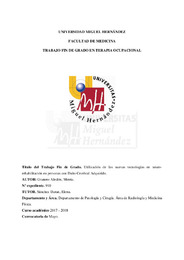Por favor, use este identificador para citar o enlazar este ítem:
https://hdl.handle.net/11000/26179Registro completo de metadatos
| Campo DC | Valor | Lengua/Idioma |
|---|---|---|
| dc.contributor.advisor | Sánchez Durán, Elena | - |
| dc.contributor.author | Granero Aledón, Mireia | - |
| dc.contributor.other | Departamentos de la UMH::Patología y Cirugía | es_ES |
| dc.date.accessioned | 2022-03-10T15:17:56Z | - |
| dc.date.available | 2022-03-10T15:17:56Z | - |
| dc.date.created | 2018-04-04 | - |
| dc.identifier.uri | http://hdl.handle.net/11000/26179 | - |
| dc.description.abstract | INTRODUCCIÓN: Se ha incrementado el uso de las nuevas tecnologías en la neurorrehabilitación de personas afectadas con daño cerebral adquirido (DCA) que ofrecen ventajas frente a la rehabilitación convencional. OBJETIVO: Revisar la evidencia científica de la práctica clínica sobre el uso de las nuevas tecnologías en la neurorrehabilitación de pacientes con DCA. MATERIAL Y MÉTODOS: Se ha realizado un proceso de búsqueda en las bases de datos Pubmed, PsycINFO y Google Academy de intervenciones en telerehabilitación en pacientes con DCA. La búsqueda se centró en las características de los pacientes, las características de las intervenciones y eficacia de las intervenciones. RESULTADOS: Se analizaron un total de 15 artículos relacionados con la telerrehabilitación en áreas cognitivas, físicas y funcionales de pacientes con DCA. Los pacientes obtuvieron mejoras significativas en el equilibrio, la fuerza y la coordinación bimanual en cuanto al déficit motor y en atención, concentración y estado de ánimo con respecto al déficit neuropsicológico en lesiones cerebrales. La tasa de integración en la comunidad y realización de AVDS fue alta y cobra un importante papel el Terapeuta Ocupacional. CONCLUSIÓN: La telerrehabilitación es una herramienta útil que mejora la calidad de vida tanto de pacientes como de profesionales. Se necesita mayor investigación que apuesten por una integración global del paciente. | es_ES |
| dc.description.abstract | INTRODUCTION: The use of new technologies has increased in the neural rehabilitation of patients affected with Acquired Brain Injury (ABI) that offer advantages over conventional rehabilitation. OBJECTIVE: To review the scientific evidence of clinical practice on the use of new technologies in the neurorehabilitation of patients with ABI. MATERIAL AND METHODS: A search process was conducted in Pubmed, PsycINFO and Google Academy databases of telerrehabilitation interventions in patients with ABI. The search focused on the characteristics of the patients, the characteristics of the interventions and the effectiveness of the interventions. RESULTS: A total of 15 articles related to telerrehabilitation in cognitive, physical and functional areas of patients with ABI were analyzed. The patients obtained significant improvements in balance, strength and bimanual coordination in terms of motor deficit and in attention, concentration and mood in patients with neuropsychological deficit in brain lesions. The rate of community integration and completion of AVDS was high and the Occupational Therapist takes on a role. CONCLUSION: Telerehabilitation is a useful tool that improves the quality of life of both patients and professionals. More research is needed to bet on a global integration of the patient | es_ES |
| dc.format | application/pdf | es_ES |
| dc.format.extent | 30 | es_ES |
| dc.language.iso | spa | es_ES |
| dc.publisher | Universidad Miguel Hernández | es_ES |
| dc.rights | info:eu-repo/semantics/openAccess | es_ES |
| dc.rights | Attribution-NonCommercial-NoDerivatives 4.0 Internacional | * |
| dc.rights.uri | http://creativecommons.org/licenses/by-nc-nd/4.0/ | * |
| dc.subject | Tele-rehabilitación | es_ES |
| dc.subject | daño cerebral adquirido | es_ES |
| dc.subject | neurorrehabilitación | es_ES |
| dc.subject | nuevas tecnologías | es_ES |
| dc.subject | telemedicina | es_ES |
| dc.subject.other | CDU::6 - Ciencias aplicadas | es_ES |
| dc.title | Utilización de las nuevas tecnologías en neuro-rehabilitación en personas con Daño Cerebral Adquirido. | es_ES |
| dc.type | info:eu-repo/semantics/bachelorThesis | es_ES |

Ver/Abrir:
Utilización de las nuevas tecnologías en neurorehabilitación en personas con Daño Cerebral Adquirido..pdf
1,01 MB
Adobe PDF
Compartir:
 La licencia se describe como: Atribución-NonComercial-NoDerivada 4.0 Internacional.
La licencia se describe como: Atribución-NonComercial-NoDerivada 4.0 Internacional.
.png)